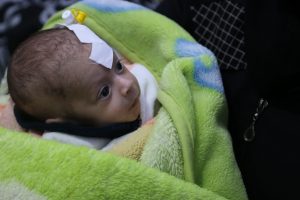
Photo credit: Save the Children.
Summary
The four-part Lancet Series on Women’s and Children’s Health in Conflict Settings (January 2021) aims to improve understanding of and address the special requirements of providing sexual, reproductive, maternal, newborn, child and adolescent health and nutrition services in conflict settings. This Series draws upon scholarship from the Bridging Research & Action in Conflict Settings for Health of Women & Children (BRANCH) Consortium. It providing insights into the nature and dynamics of women’s and children’s health and nutrition in diverse conflict contexts globally. The Consortium aimed to complement the previous work of operational and academic colleagues in the field, including:
- work examining the debilitating effects of conflict on public health systems and outcomes, including among women and children;
- the low quality and quantity of available evidence on public health intervention effectiveness in crisis settings; and
- the insufficiency of available data and guidance for monitoring, evaluating, and informing humanitarian health activities.
Series & Comments
Series papers articulate a way forward to fill immediate evidence and guidance gaps, as well as longer term action to ensure the most effective humanitarian health response for conflict-affected women and children. The series includes:
- First Series paper – Paul Wise and colleagues examine the contemporary political and security challenges that define areas affected by armed conflict and drastically impact the realities of humanitarian action on the ground.
- Second paper – Eran Bendavid and colleagues use international statistical databases to estimate that conflict had displaced almost 36 million children and about 16 million women as refugees, asylum seekers, or internally displaced people by 2017.
- Third paper – Neha Singh and colleagues report findings on the prioritization and delivery of sexual, reproductive, maternal, newborn, child, and adolescent
health, and nutrition interventions from mixed methods case studies of the humanitarian health response in ten conflict-affected countries: Afghanistan, Colombia, Democratic Republic of the Congo, Mali, Nigeria, Pakistan, Somalia, South Sudan, Syria, and Yemen. - Fourth paper – Michelle Gaffey and colleagues address the importance of accounting for context when determining intervention priorities for women and children affected by conflict.
- Finally, in a Comment linked to this Series, Zulfiqar Bhutta and members of the BRANCH Consortium steering committee outline some ways forward for the humanitarian health community to do better for women and children in the context of armed conflict.